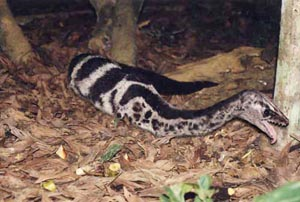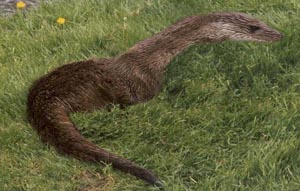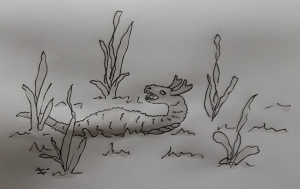Difference between revisions of "Garke"
From World of Entorais Wiki
Jump to navigationJump to search (removed file) |
m (Text replacement - "Sub-Species" to "Notable Sub-Species") |
||
| Line 23: | Line 23: | ||
;Reproduction:Males and females will mate in the fall. Females will dig a den and brood during the winter, with live birthing young the following spring. The number of young, gestational period and age to reach sexual maturity varies with sub-species. | ;Reproduction:Males and females will mate in the fall. Females will dig a den and brood during the winter, with live birthing young the following spring. The number of young, gestational period and age to reach sexual maturity varies with sub-species. | ||
==Sub-Species== | ==Notable Sub-Species== | ||
===Banded Garke=== | ===Banded Garke=== | ||
:The banded garke is a predator of the more heavily forested areas of Anexea. | :The banded garke is a predator of the more heavily forested areas of Anexea. | ||
Revision as of 01:16, 20 April 2023
About
- Legless mammalian predators and scavengers common throughout Entorais. Garke known for their speed and vicious tearing bites.
- Common Names
- Garke
Description
- Classification
- Mammal
- Size
- Varies significantly with sub-species. Average adults size is 10-30 kilograms (22-66 pounds) and 75-150 centimetres (2 feet 6inches - 5 feet) in length.
- Appearance
- Short furred legless mammal, with long necks, thick bodies and medium tails. They move about on their calloused padded underbellies.
- Sexual dimorphism
- Females tend to be 25% heavier than males.
- Variance
- Differences based on sub-species.
Ecology
- Habitat
- found in a wide variety of habitats. Each sub-species is adapted to their particular biomes.
- Diet
- Garke will prey upon small animals as individuals and in packs are cunning and aggressive carnivores, often taking on prey much larger than themselves, using their ferocity and numbers to their advantage.
Behaviour
- Social grouping
- Generally found in packs of 2-6 individuals.
- Temperament
- Generally aggressive, but tend towards stealth and endurance hunting styles.
- Intelligence
- Cunning Animal.
- Reproduction
- Males and females will mate in the fall. Females will dig a den and brood during the winter, with live birthing young the following spring. The number of young, gestational period and age to reach sexual maturity varies with sub-species.
Notable Sub-Species
Banded Garke
- The banded garke is a predator of the more heavily forested areas of Anexea.
- Black-and-white banded appearance, with spots along the neck and head.
Black Garke
- Banad Garke is a predator of the forested areas of Anexea,
- They have black-green colouration with very dark brown and green brindling on their hides.
- The black Garke has teeth which are loose in their jaw, and will break off in the wounds of prey. These embedded teeth with often keep the wound bleeding, and can cause an infection if left untreated. This allows for the banad garke to later track and catch any prey might escape and initial attack.
Brown Garke
- Balakwä Garke is a predator of the grassland areas of Anexea. They are of a dark brown colouration with lighter brown ruff.
Desert Garke
- Balyfre Garke are a voracious predator of Krolaryn Wastes, and Waejiran Desert. They are a short furred creature, with tawny colouration and light through dark brown dappled hides.
Horned Garke
- The horned garke is a smaller variety, possessing light brown to grey fur, and sporting a pair of outward turned horns on their heads. These are used for defensive purposes against larger predators.
Ring Spotted Garke
- The largest of the garke species reaching 200 kilograms and 4-5 metres in length. Their hide tends to cinnamon/ginger colours with brown or black ring shaped speckles 1-3 centimetres in diameter along their backs.
- These beasts have a toxic bite, which can induce paralysis from the slightest scratch. They often will attack prey, then withdraw and let the poison finish off the kill.
- Fortunately they tend to be found either solo or in pairs unlike their smaller cousins.
Domestication
- General
- Sometimes farmed for furs in northern areas.
- Resources
- Pelts, Meat.


